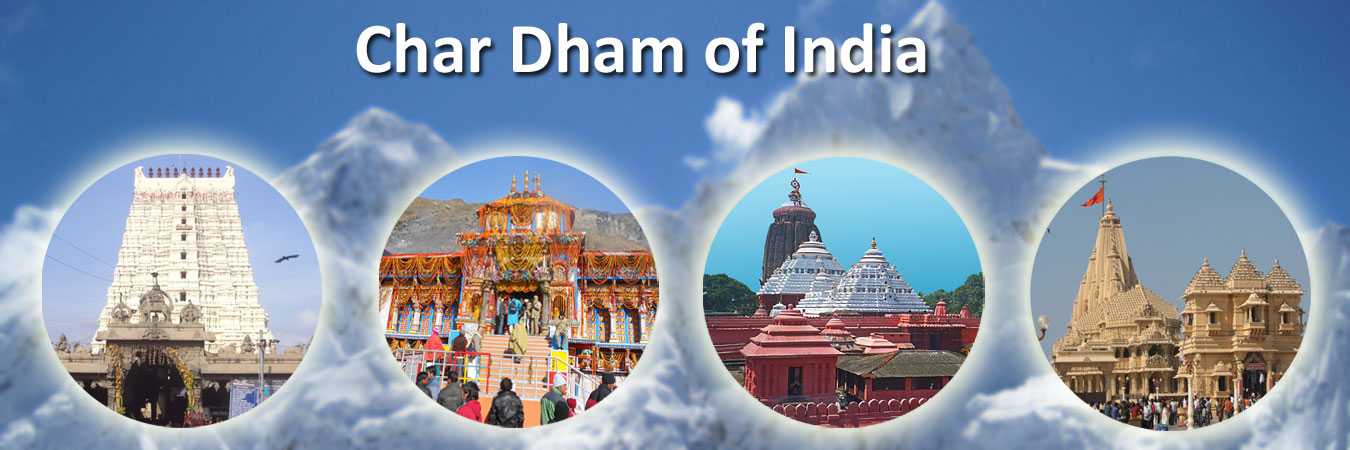The 4 Abodes of Lord Vishnu
Lord Vishnu, who is the preserver among the Trimurtis is worshipped across India. Lord Vishnu takes Avatar (incarnation) to uplift the Dharma in this world. The Dashavataras are well-known and there are many famous temples related across India that pilgrims visit every year and get blessed by Lord Vishnu.
Apart from that, many temples are grouped based on Avatars, Leelas, visits by Saints, sacred hymns, Ages, etc.
- “Char Dham – Four Abodes” are temples at Yamunotri, Gangotri, Kedarnath, and Badrinath grouped in Uttarakhand.
- Like that, the “Chote Char Dham–Small Four Abodes of Lord Vishnu” are grouped based on the act of Lord Vishnu.
Shaantaakaaram Bhujagashayanam Padmanaabham Suresham
Vishva Aadhaaram GaganaSadrusham Megha Varnna Shubha Angam|
LakshmiKaantam KamalaNayanam YogibhirDhyaana Gamyam
Vande Vishnum Bhava Bhaya-Haram SarvaLokaEkaNaatham ||
Badrinarayana
Badrinath, which is also called Badrikashram (10,000 feet approx. above sea level) is a place in the Himalayas, Uttarakhand, Northern part of India. The first act of “Waking up of Lord Vishnu and Taking Holy Bath” is in this Divya Kshetra.
It is one of the “Swavayam Vyakta Kshetras” among the Self-Manifested 108 Vaishnavaite Divya Desams. The Lord here is known as “Badri Vishal or Badrinarayana”.
The Lord is in Padmasana posture. Legend says that this forest area was covered by Badri Trees (Berry or Jujube fruit) and Goddess Mahalakshmi took the form of Badri Tree to give shade to Lord Badrinarayana. Lord Narayana selected this place for meditation.
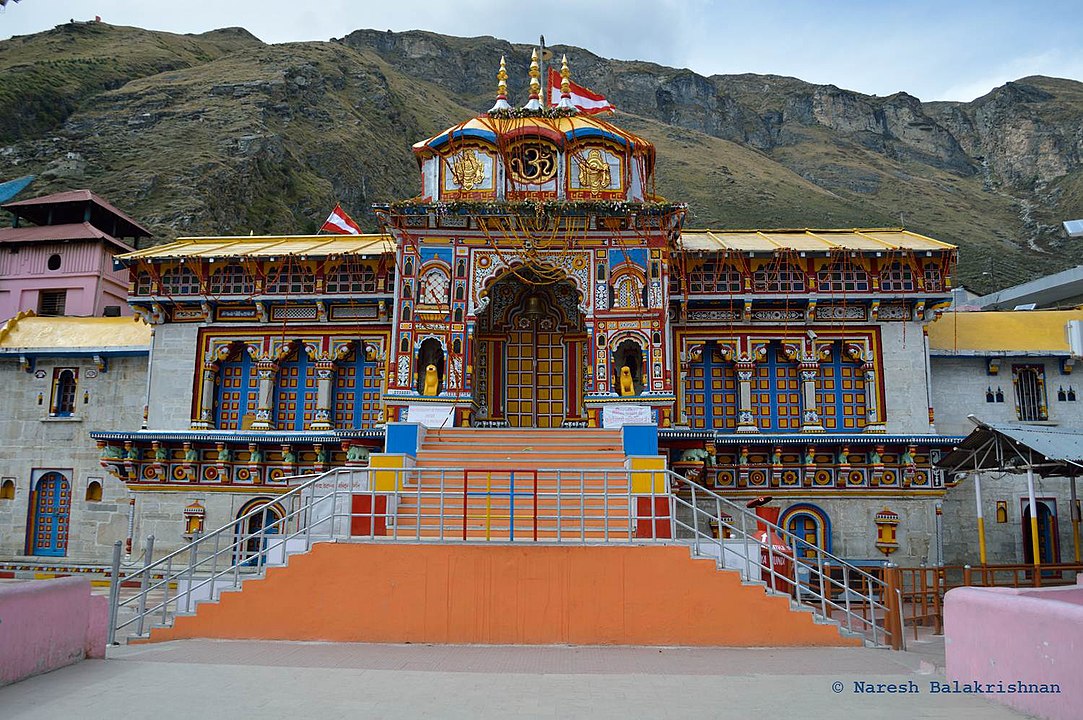
Many puranas regard this place as equivalent to heaven. River Alakananda flows in front of this shrine. People perform rituals near Brahma Kapala for their ancestors. The temple is in between Nar and Narayana mountains. Kerala priests “Namboodris” perform puja. They are also called Rawals. The puja process is set up by Adi Sankaracharya. Maha abhishekam will start early morning with ghee, yogurt, milk, sandalwood, saffron, etc., continuously chanting the mantras.
Special Abhishekam— Shravani Abhishekam is done in Shravana month. The temple is closed during winter (mid-Nov to mid-Apr). During that time, the Utsava Murthy is brought to Joshimutt (6000 feet approx.).
Before leaving for Joshimutt, the priest dresses the Lord in woolen vests and cotton muslin dresses on top of that. He is decorated with the finest silk, jewelry, and orange flowers.
Along with Badrinath, there are other deities- Narada, Uddhava, Kubera, Garuda, Silver Ganesha, Nar, and Narayana in the Garbha Griha (sanctum sanctorum). There is Taptha Kund, a natural hot water spring where pilgrims take a holy dip. Alwars have also sung in praise of this Lord. Adi Sankaracharya has set up Mutt in Badrinath to spread the Hindu Philosophy in the north.
Dwarakdesh
Shanku Chakra Gadha pani!
Dwaraka Nilayachyuta!
Govinda Pundarikaksha!
Rakshamam Sharanagatham
Dwaraka which is also called Dev Bhoomi is in Gujarat which is the Western part of India. The second act of “Dressing up–Divya Alankar” is in this Divya Kshetra which is also one of the 108 Divya Desams. As the name mentions it’s the gateway to heaven. It is also one of the Seven Mukthi sthalas (places for Salvation).
Dwaraka is a place where Lord Krishna has set up the city built by God’s Architect Vishwakarma. All the people of Mathura were shifted to Dwaraka. The Lord here is known as ‘Dwaraka desh’. Deep daan is very divine in River Gomati. It is considered the most popular city of those times. It shows the prosperity of the place.
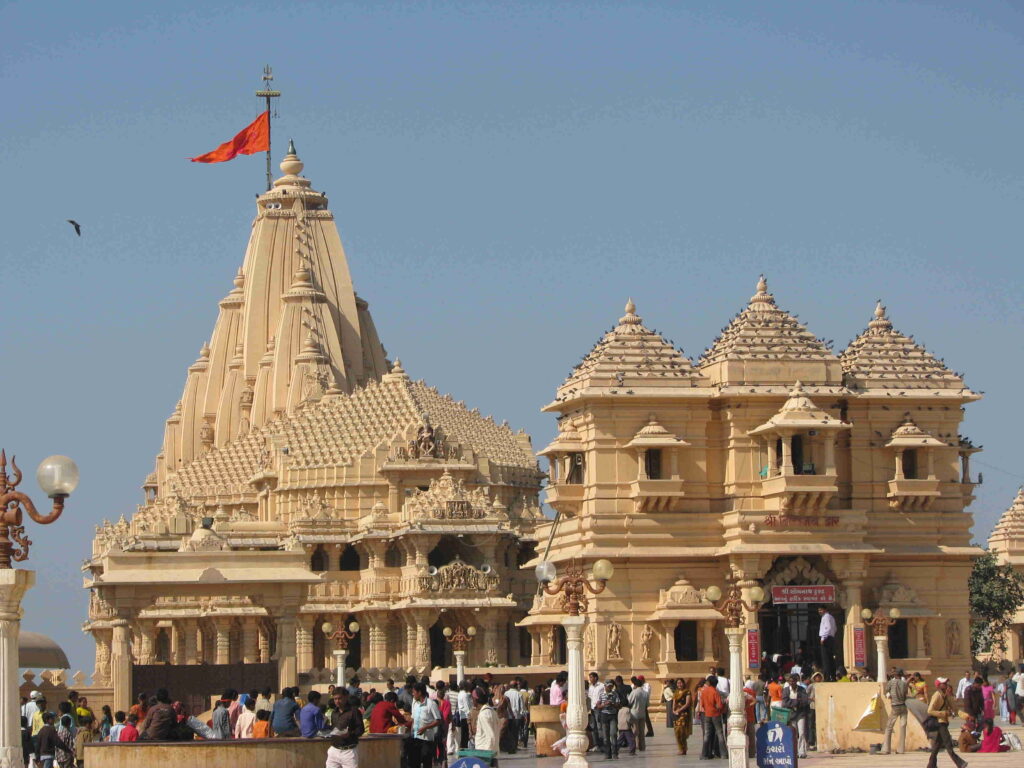
The current temple dedicated to Dwarkadesh was built by Vajranabha, grandson of Lord Krishna. Lord Krishna is in standing posture with four arms bearing Shanka (Conch), Chakra (Discus), Gadha (Mace), and Padma (Lotus).
The specialty of this temple is that Mother Devaki is facing Lord Krishna. There is a separate temple for Goddess Rukmini Devi. Lord Krishna of Dwaraka is beautifully decorated from the day start of Mangala Arati till Shayan Arati (Ekanta Seva) at night. After Abhishekam, the adornment starts with Pitambar (Yellow silk garments). It is like a Pyjama (Salwar type), then Vagho (one piece of cloth), and four pieces of cloth for four hands of the Lord.
The ornaments are Chandanmala, Betelnut mala, and Vaijayanthimala. The crown is named ‘Kuve’ which has Chandrakala beautifully ornamented. The conch and the discus are decorated with precious diamonds and stones. Great Acharyas, Adi Sankaracharya, and Ramanujacharya have visited this shrine. Adi Sankaracharya has set up Mutt in Badrinath to spread the Hindu Philosophy in the Western region.
Lord Jagannath
Neelachala Nivasaya Nithyaya Paramathmane!
Balabadra Subadhrabhyam Jagannathaya te namah!!
Puri Jagannath is a temple dedicated to Lord Jagannath (Mahavishnu – Ruler of the World) situated in Puri, Orissa in the Eastern part of India. The third act “Divine Dining Feast” is the world-famous richest prasadam offered. Many Puranas have mentioned the story of how Lord Jagannath, Sister Subhadra, and Brother Balaram reside in this temple.
King Indradyumna dreamt of the Lord as “Neela Madhava” and wanted to get his Darshan. He told the same to his ministers and asked them to find out how to get the Lord’s Darshan. Vidyapati, one of the Brahmin priests, set out to search and found Lord Neela Madhava prayed by a tribal group. They did not allow any of them to get the Lord’s Darshan. Vidyapati, somehow, managed to marry the daughter of the tribal chieftain and requested for the Lord’s Darshan.
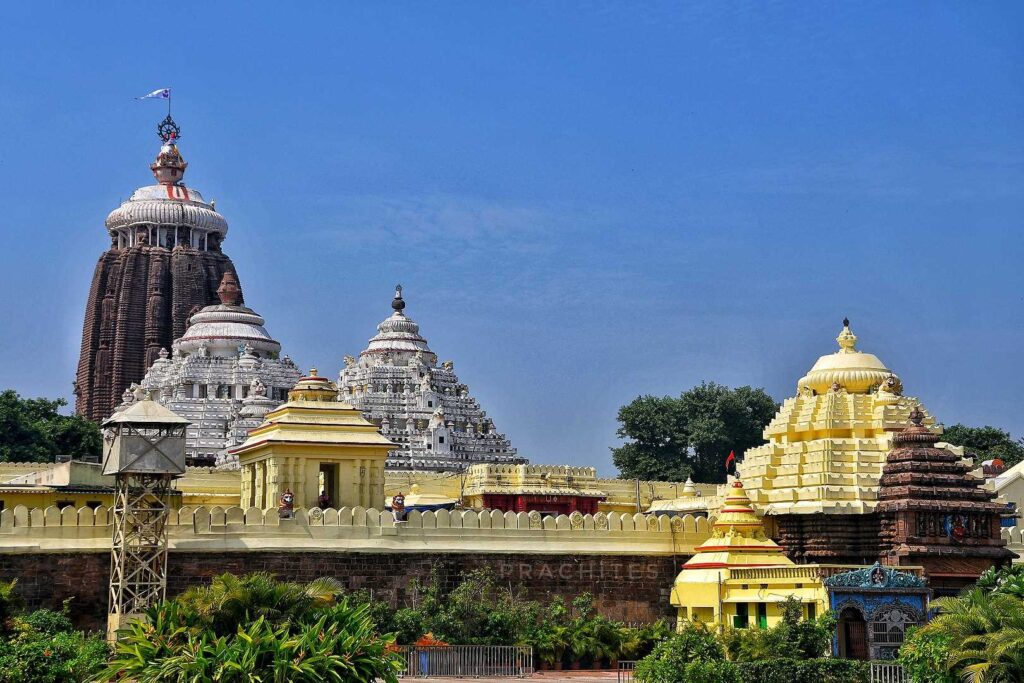
They agreed on the condition that they would take him blindfolded to the place. Vidyapati agreed and got the Divine vision of the Lord. He cleverly put mustard seeds on the path which grew later and he showed the path to the King. Unfortunately, when the King reached the place, he could not find the Lord. The vexed king desperately cried for the Darshan. He heard a celestial voice informing him to come to the seashore where he could find a fragrant wood floating that could be used to carve out the Divine idol. Thus, he got the wood but was waiting for a sculptor.
Vishwakarma appeared in disguise as an artisan and informed him that he would carve the idols provided he is not disturbed until the carving is complete. He closed the door and days passed. As King did not hear any sound even after a few days, he was worried. Impatiently he opened the doors and found the idol half-complete as is seen today. The Lord informed that he would like to be in this form and bless the devotees.
As mentioned, the Lord’s naivedyam (food offering) is called Bhog (food), and the prasadam is considered sumptuous to consume. The kitchen is considered to be the largest temple Kitchen in the world. Daily Naivedyam is offered six times to the Lord. Naivedyam offered in the morning is called ‘Gopala Vallabha Bhoga’. It consists of around seven items.
At 10.00 a.m. ‘Sakala Dhupa Naivedyam’ is offered with thirteen items. Then, ‘Chatra Bhoga’ in the afternoon is given to pilgrims. Then, ‘Madhyahna Dhupa’, the heavy meal; ‘Sandhya Bhoga’ at night, and the last one is Bada ‘Simhara Bhoga’. The prasadam is called “Mahaprasad”. Around fifty-six varieties of Naivedyams are prepared in this kitchen.
The specialty of the Mahaprasad is that Goddess Mahalakshmi herself is believed to supervise the Kitchen. Cooking is done in earthen pots. There is an open market named Anand Bazar where Prasadam is sold. The Adi Sankaracharya visited the temple and set up Mutt there.
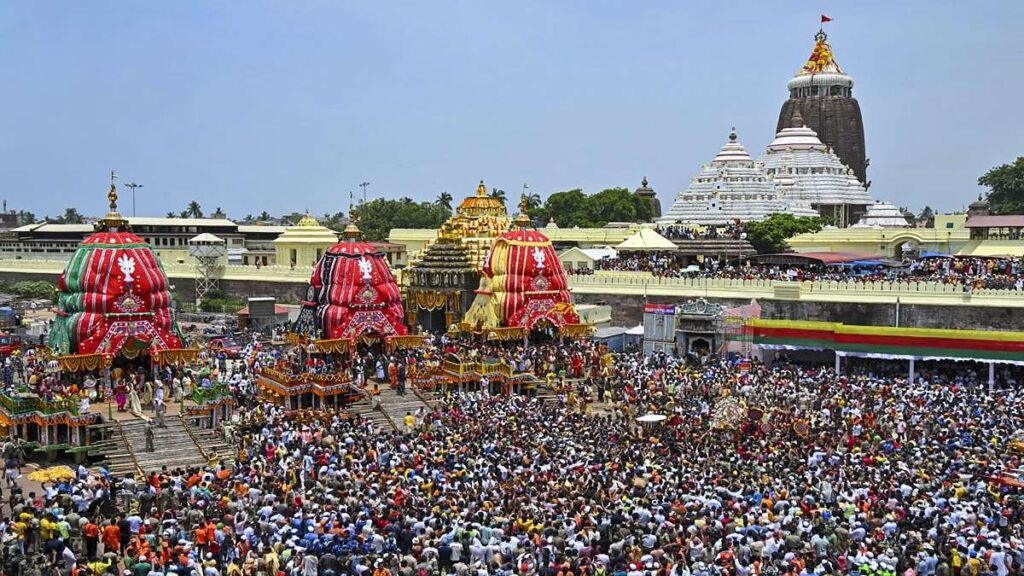
Puri Jagannath Rath Yatra is world famous where millions of pilgrims flock to get the Darshan of the Lord on the gigantic chariot. Enchanting Lord Vishnu in the reclining posture gives bliss to the devotees. In the four Dhams, reclining posture is in two places from the South. Some consider that Thirupullani near Rameshwaram and Sri Rangam for Shayan (lying) are legendary. Both places are related to Srimad Ramayana.
Lord Ranganatha Swami of Srirangam
Kaveri VirajaSeyam Vaikuntam Rangamandiram!
Sa Vasudevo Rangesha: prathyaksham paramam padam!!
Srirangam is the foremost Divya Desam which is considered the resting place for Lord Vishnu. Alwars have sung the praise of Lord Ranganatha elegantly. It is Swayam Vyaktha Kshetra (Self- Manifested). Here Lord reclines on a huge Adi Sesha (Serpent). The idol was first given by Lord Vishnu to Lord Brahma, then to the Ikshvaku dynasty, and finally to Vibheeshana by Lord Rama himself.
Lord Ranganatha wished to reside on the banks of River Kaveri and Kollidam. Ekanta Seva is unique in Srirangam, especially during Ira Pathu Seva. This practice was started by Ramanuja. Sri Ramanujacharya served this temple for many years.
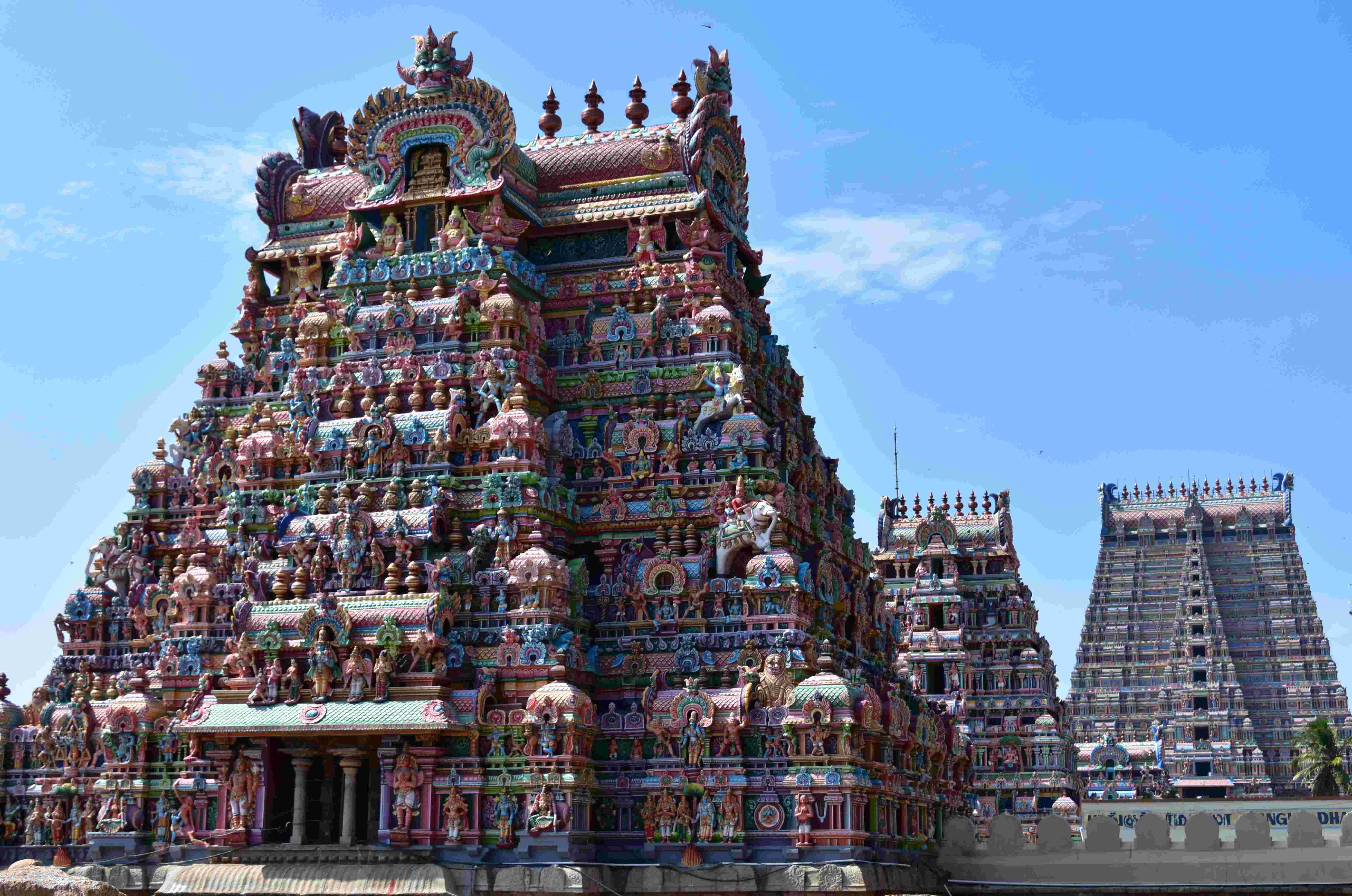
The unique playing of Veena is soothing to hear. Adi Sankaracharya visited this temple. Many hymns highlight the beauty of Sri Rangam temple. The greenery in this temple is considered to be equivalent to Sri Vaikuntam which made the Lord rest happily in this place.
Many songs question the Lord why he is reclining; is it because he walked with Sita Devi in the forest or he had danced on snake Kaliya or walked to get three steps of land from Mahabali? The beauty of the Lord is to the fullest when the Lord is in a reclining posture as seen in Sri Rangam.
Wherever the Lord is, whatever he does, it gives ecstasy to the devotees as they visit the temples for Darshan and blessings. At each place, he is celebrated with pomp and glory. His beauty steals the minds of the devotees.
In the North, he does penance for the wellness of the world; in the West, he shows his beautiful form by dressing himself which cools the minds of the devotees; in the East, he wants to feed the devotees, in the South, he wanted to maintain peace and give salvation to his devotees. Thus, he is ready to save the world from the clutches of the wicked and guards from all sides by performing simple acts.
Lord Adi Jagannatha of Thirupullani
Thirupullani (near Rameshwaram), is the Southern Divya Desam, where Lord Rama is in a reclining posture. Here Lord is in ‘Yoga Nidra’ pose. The temple is one of 108 Divya Desams. It’s on the way to Rameshwaram. This temple is dedicated to Lord Adi Jagannatha perumal.
It is believed that King Dasaratha first performed Putra Kameshti Yagna in this place and later in Ayodhya. In the same temple is another important shrine where Lord Rama is in reclining posture on Darbha Grass. It is believed that Lord Rama did penance for the Lord of the Ocean (Sagara) to give way to reach Lanka. Alwars have praised the Lord in this Divya Desam. Pitru Tharpana (rituals for ancestors) are performed in Sethu Samudra (on the shores of Sethu). As devotees, we are blessed by visiting these places.
